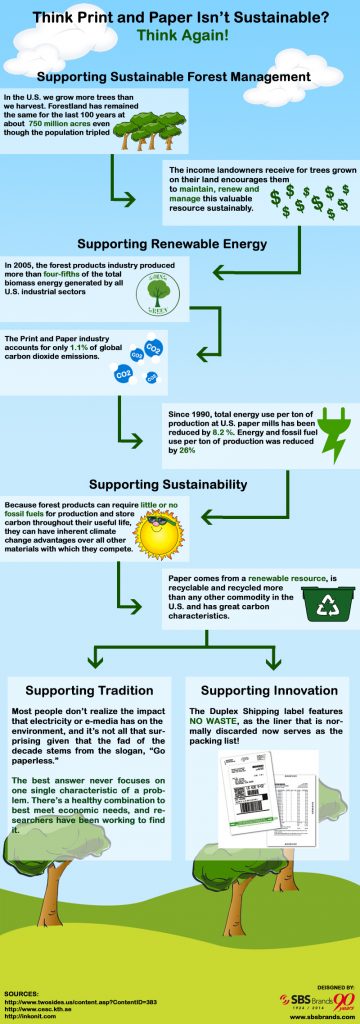What is Sustainable Printing and Paper?

Think Print and Paper Isn’t Sustainable—Think Again!
The paper and the print industry have unfairly gained a reputation as harmful to the environment, when the reality is almost the exact opposite. To get the facts and help dispel this myth, our sister company, Superior Business Solutions, created an Infographic that spells out the sustainability of both print and paper. You can see the Infographic below and get the facts on sustainable printing and paper.
Paper is Renewable and Recyclable
Paper is made from a renewable resource which immediately makes it a very eco and green material. Deforestation is a sad reality, but the paper industry as a whole is not tied to this problem. Organizations such as Forest Stewardship Council (FSC) strive to promote responsible management of the world’s forests. As a matter of fact, the amount of forestland in the U.S. has remained the same for the last 100 years. This is even more impressive when you consider that over the same period of time the population in the United States has tripled. Paper is also recyclable. It is one of the easiest materials to recycle and it has an extremely high rate of recycling. Between being sustainable and recyclable it is hard to be more eco than paper.
Paper Manufacturing is Incredibly Efficient
As if being made from renewable resources and being highly recyclable weren’t enough, many paper mills do their part to reduce their energy consumption and further reduce the environmental impact paper and the print industry has on the environment. Since 1990 the total energy use per ton of production at U.S. paper mills has been reduced by 8.2 percent while energy and fossil fuel use per production ton was reduced by 26 percent. The print and paper industry accounts for only about 1 percent of global carbon dioxide emissions—this is a staggeringly low number and a testament to the efforts of these mills. According to a recent white paper by TwoSides.com, “Nearly two-thirds of the energy used by U.S. pulp and paper mills is self-generated using renewable carbon-neutral biomass.”
Digital Communication is not as Eco as You May Think
There is a common misconception that digital communication is more eco than paper and print – this isn’t a fair comparison. While tablets, digital readers and smartphones are great, and amazing developments that make life easier and better is many ways, there are eco drawbacks. Electronic devices, especially the batteries, are not very environmentally friendly and while recycling rates for electronics is on the rise, it is still rather low. This is not to say we should start a movement to stop using electronic communication and try to restore print as the primary form of information exchange, but there are green merits and eco drawbacks to digital communication. There is room for both mediums—there are times when digital communication is the best choice and there are times when print is the superior option. It would be in poor judgment to not consider paper and printing simply because you’ve heard rumors these methods are not eco.
Created by: Superior Business Solutions
Tagged






